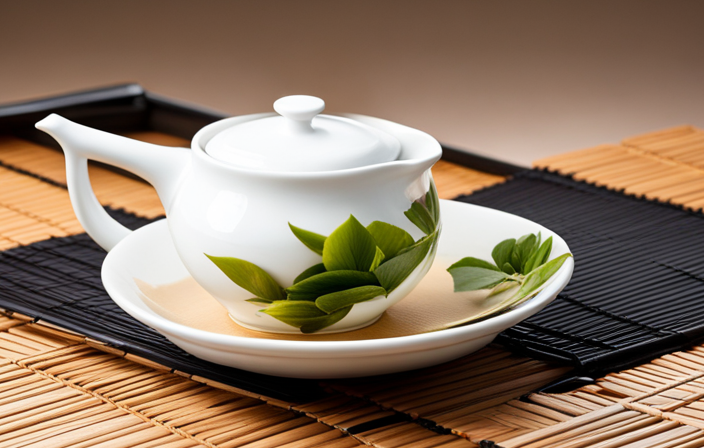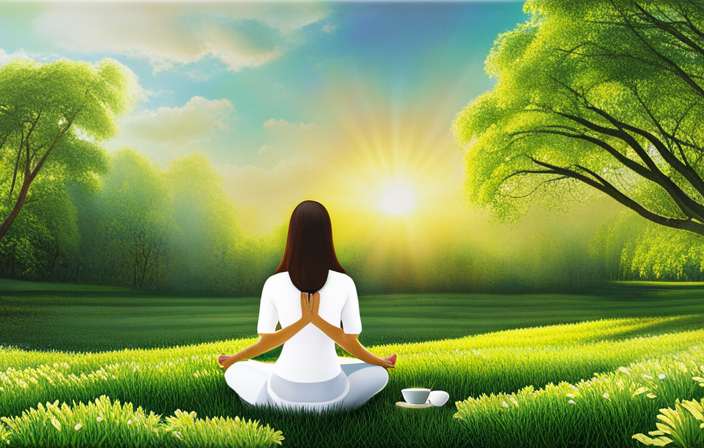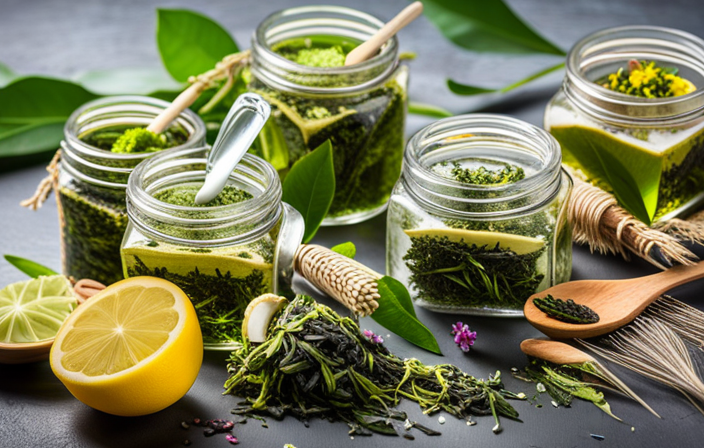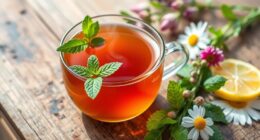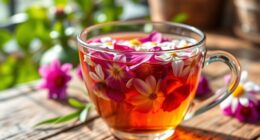As someone passionate about tea, I’ve held the conviction that crafting the ideal cup of green tea is akin to conducting a symphony. Every component needs to blend seamlessly to forge an absolutely splendid experience.
In this article, I will divulge the secrets of mastering this art form, from selecting the finest tea leaves to serving with elegance.
Get ready to embark on a journey where every sip is a celebration of grace and refinement. Let’s uncover the art of perfect green tea brewing together.
Key Takeaways
- Necessary equipment: kettle with water temperature control, teapot or tea infuser, tea timer or stopwatch, thermometer or electric kettle with temperature control, tea brewing accessories for serving
- Considerations when selecting green tea: aroma, taste, and quality
- Importance of water temperature: affects taste and quality of green tea
- Measuring the perfect amount of tea: intuition and experience, specific amounts for different types of tea
Gather the Necessary Equipment
I need to gather the three essential pieces of equipment for brewing the perfect cup of green tea.
First, I’ll need a kettle with water temperature control. This will allow me to heat the water to the ideal temperature for green tea, which is around 175°F (80°C).
Next, I’ll need a teapot or a tea infuser. This will help me steep the tea leaves properly and extract the flavors and aromas.
Lastly, I’ll need a tea timer or a stopwatch to ensure that I steep the tea for the right amount of time. This will prevent overbrewing or underbrewing, resulting in a perfectly balanced cup of green tea.
With these tea brewing accessories, I can serve others a delightful and refreshing cup of green tea.
Choose the Finest Green Tea
To find the finest green tea, one should carefully consider the aroma, taste, and quality of different varieties before making a choice. The selection process is crucial in ensuring a delightful tea experience. Below is a table that provides an overview of some popular green tea varieties, highlighting their unique characteristics and flavors:
| Variety | Aroma | Taste | Quality |
|---|---|---|---|
| Matcha | Rich and grassy | Smooth and creamy | High |
| Sencha | Fresh and vegetal | Crisp and refreshing | Medium to high |
| Dragon Well | Nutty and chestnut | Toasty and sweet | High |
| Gunpowder | Smoky and earthy | Bold and robust | Medium to high |
Optimal Water Temperature
While brewing green tea, it’s important to consider the optimal water temperature for extracting the best flavors and aromas. Water temperature control is crucial because it directly affects the taste and quality of the tea. The ideal temperature for brewing green tea is around 175 to 185 degrees Fahrenheit. This temperature range allows the delicate tea leaves to unfurl and release their natural flavors, resulting in a smooth and refreshing cup of tea.
To achieve the perfect water temperature, it’s recommended to use a thermometer or an electric kettle with temperature control. Boiling water can scorch the delicate leaves, leading to a bitter taste. On the other hand, water that’s too cool may not fully extract the flavors, resulting in a weak and bland tea.
Achieving the optimal water temperature is the key to unlocking the full potential of green tea. It ensures that the flavors are well-balanced and the aromas are enticing. So next time you brew green tea, pay attention to the water temperature, and experience the difference it makes in the tea flavor extraction.
Preparing the Teapot
I carefully rinse my teapot with warm water, ensuring it’s clean and ready to brew the perfect cup of tea.
The choice of teapot material is crucial, as it can affect the taste and aroma of the tea.
Additionally, the steeping time varies depending on the type of tea, allowing me to extract the optimal flavors.
Water Temperature Importance
Maintaining the ideal water temperature is crucial to extracting the full flavor and aroma from the tea leaves. The variations in water temperature can significantly impact the taste of your tea. Here are three key points to consider:
-
Boiling Water (100°C): This temperature is perfect for black teas, as it helps release the deep, robust flavors and aromas. The hot water brings out the tea’s boldness, creating a rich and satisfying cup.
-
80-85°C: For delicate green teas, this temperature range is ideal. It allows the leaves to unfurl gently, resulting in a smooth and refreshing brew. The lower temperature preserves the tea’s natural sweetness and grassy notes.
-
70-75°C: White teas thrive at this lower temperature range. The subtle flavors and delicate aromas of white teas are best extracted with cooler water. This temperature ensures a light and nuanced cup, with floral and fruity undertones shining through.
Now that we understand how water temperature impacts tea flavor, let’s move on to exploring the importance of steeping time variations.
Steeping Time Variations
During the steeping process, I can experiment with different steeping times and find the perfect balance of flavor and strength for my green tea. Steeping time variations play a crucial role in unlocking the full potential of this beloved beverage.
Green tea, known for its numerous health benefits, contains powerful antioxidants and compounds that promote overall well-being. By adjusting the steeping time, I can control the intensity of these beneficial elements. A shorter steeping time results in a lighter, more delicate flavor, while a longer steeping time yields a stronger, bolder taste.
It’s fascinating how a few extra seconds can make such a difference in the final outcome. By exploring the various steeping time variations, I can tailor my green tea experience to suit my personal preferences and enjoy all the health benefits it has to offer.
Teapot Material Preferences
Two common teapot materials are porcelain and clay, but I prefer the latter as it enhances the flavor of my green tea. When it comes to brewing the perfect cup, the choice of teapot material can make a significant difference. Here are three reasons why ceramic is the ideal choice for tea enthusiasts:
-
Heat retention: Ceramic teapots have excellent heat retention properties, allowing the water to stay at the optimal temperature for longer periods. This ensures that the delicate flavors of green tea are fully infused into the brew.
-
Even heat distribution: The porous nature of ceramic distributes heat evenly, preventing any hotspots and ensuring a consistent brewing process. This results in a well-balanced cup of tea every time.
-
Natural brewing environment: Clay teapots, specifically those made from high-quality ceramics like Yixing clay, enhance the natural flavors of the tea. The porous clay absorbs the tea oils over time, creating a unique and rich flavor profile with each brew.
Measuring the Perfect Amount of Tea
I always eyeball the perfect amount of tea leaves for my brew. When it comes to measuring accuracy, I believe that experience and intuition play a crucial role.
The key to achieving the ideal tea strength balance lies in understanding the characteristics of the tea leaves and the desired flavor profile. Each type of tea requires a specific amount to unlock its full potential.
For delicate green teas, a lighter touch is needed, usually around 2 grams per 8 ounces of water. This ensures a subtle, refreshing taste without overpowering bitterness.
However, for more robust black teas, a slightly stronger brew is desired, usually around 3 grams per 8 ounces of water.
The Right Steeping Technique
To brew the perfect cup of green tea, it’s crucial to master the right steeping technique.
The water temperature plays a vital role in extracting the delicate flavors and aromas, so be sure to heat it to around 175°F.
Steeping time can vary depending on the type of green tea and personal preference, but generally, a range of 1-3 minutes should suffice.
Don’t be afraid to experiment with different tea leaves to find your ideal balance of taste and strength.
Water Temperature Importance
Honestly, adjusting the water temperature is crucial for achieving the perfect cup of green tea. The impact of water temperature on flavor can’t be overlooked. As someone who desires to serve others the best cup of green tea possible, here are three key points to keep in mind:
-
The ideal temperature for steeping green tea is around 175°F (80°C). This temperature allows the delicate flavors to fully develop without becoming bitter.
-
Boiling water, at 212°F (100°C), is too hot for green tea and can result in a bitter taste. It’s important to let the water cool down for a few minutes before pouring it over the tea leaves.
-
If the water is too cool, below 160°F (71°C), the tea may taste weak and lack the full range of flavors. It’s essential to find the right balance to bring out the best qualities of the tea.
Steeping Time Variations
One can experiment with different steeping times and find the perfect balance for their green tea by using a timer and adjusting the taste preferences accordingly. Steeping time variations play a crucial role in unlocking the full flavor profiles of green tea. The duration of steeping can greatly impact the taste, strength, and overall experience of the tea. To help you navigate the world of steeping times, here is a table that outlines the general guidelines for different types of green tea:
| Green Tea Type | Steeping Time |
|---|---|
| Sencha | 1-2 minutes |
| Matcha | 30 seconds |
| Dragon Well | 2-3 minutes |
| Gyokuro | 2-3 minutes |
| Jasmine Green Tea | 3-4 minutes |
Experimenting With Tea Leaves
While I was experimenting with different tea leaves, I discovered that using a higher quality loose leaf tea resulted in a more flavorful and aromatic cup of tea. The experience of exploring different tea flavors and experimenting with brewing methods has been truly enlightening.
Here are three key findings from my tea journey:
-
Variety: By trying different types of tea leaves such as green tea, black tea, and herbal tea, I was able to experience a wide range of flavors and aromas.
-
Steeping Techniques: I experimented with different brewing methods, including adjusting water temperature and steeping time, to bring out the best flavors in each tea type.
-
Quality Matters: It became evident that using high-quality loose leaf tea significantly enhances the taste and aroma of the tea, compared to tea bags or lower-grade varieties.
Through these experiments, I’ve come to appreciate the importance of evaluating the tea’s quality and its impact on the overall tea-drinking experience.
Evaluating the Tea’s Quality
I can tell the tea’s quality by examining its aroma and taste. When evaluating tea flavor, it is crucial to pay attention to the nuances and intricacies that dance on the palate. Each sip should be a delightful journey, revealing layers of flavors that harmonize perfectly. Aroma and taste go hand in hand, as the aroma provides a glimpse into the story of the tea. The fragrance can range from floral and grassy to nutty or even fruity. To help you better understand the relationship between aroma and taste, here is a simple table:
| Aroma | Taste |
|---|---|
| Floral | Light and delicate |
| Grassy | Fresh and crisp |
| Nutty | Smooth and rich |
Serving With Grace and Elegance
When it comes to serving tea, there’s an art to doing it with grace and elegance. From the moment the teapot is brought to the table, every movement and gesture should exude a sense of poise and refinement.
Whether it’s the proper way to pour tea or the presentation of tea accessories, attention to these details can enhance the overall tea serving experience.
Tea Serving Etiquette
Serving a cup of tea with the right amount of grace and elegance is essential for creating a memorable tea experience. In the world of tea, there are various rituals and customs that hold great cultural significance. Here are three key aspects of tea serving etiquette that add a touch of sophistication to the process:
-
Preparing the tea: Carefully selecting the tea leaves, measuring the perfect amount, and steeping them at the right temperature and time are crucial steps in creating a flavorful brew.
-
Presenting the tea: Serving tea in a beautiful teapot or a traditional bowl, accompanied by delicate tea cups, adds an elegant touch to the experience. Attention to detail, like using a tea tray or a cloth for spills, shows respect for the tea and the guests.
-
Pouring the tea: The way the tea is poured reflects the host’s skill and knowledge. It’s customary to pour the tea slowly and smoothly, ensuring each cup receives an equal amount.
Presentation Tips for Tea
To create an elegant presentation for tea, start by carefully selecting a beautiful teapot or traditional bowl, and then pour the tea slowly and smoothly, ensuring each cup receives an equal amount. Paying attention to tea presentation techniques can elevate the tea serving rituals and create a memorable experience for your guests. Here are some essential tips for a stunning tea presentation:
| Presentation Techniques | Tea Serving Rituals |
|---|---|
| Use a beautiful teapot or traditional bowl | Prepare the tea with care |
| Pour the tea slowly and smoothly | Ensure each cup receives an equal amount |
| Serve tea in delicate tea cups | Offer sugar, milk, or lemon |
| Use a tea tray or serving stand | Provide small snacks or sweets alongside the tea |
Enhancing Tea Serving Experience
With a touch of finesse and a sprinkle of creativity, I can elevate the tea serving experience to a whole new level. Here are three tea serving tips that will enhance the flavors and leave your guests delighted:
-
Temperature Control: To truly bring out the flavors of tea, it’s crucial to brew it at the right temperature. Green tea, for instance, should be brewed at around 175°F (80°C) to avoid bitterness and ensure a smooth taste.
-
Time Management: Steeping time is equally important. Oversteeping can lead to a bitter taste, while understeeping may result in a weak flavor. For green tea, a steeping time of 2-3 minutes is ideal to achieve a perfect balance of flavors.
-
Tea Ware Selection: The right tea ware can enhance the overall tea serving experience. Opt for glass or ceramic teapots that allow you to appreciate the tea’s color, aroma, and movement as it brews.
Ensuring a Clean and Tidy Finish
I always strive for a clean and tidy finish when I’m brewing my green tea. It’s not just about the taste and aroma, but also about the presentation and experience. To achieve this, I have discovered some cleaning tips and storage recommendations that I would like to share with you.
| Cleaning Tips | Storage Recommendations |
|---|---|
| Use warm water and mild dish soap to clean your teapot and teacups. | Store your green tea leaves in an airtight container away from direct sunlight. |
| Rinse your teapot and teacups thoroughly after each use to remove any residue. | Keep your green tea in a cool and dry place to maintain its freshness. |
| Use a soft brush or cloth to gently clean the tea stains on your teapot and teacups. | Avoid storing your green tea near strong-smelling foods or spices to prevent flavor contamination. |
Mastering the Art of Green Tea Brewing
Although there are various methods to brew green tea, finding the perfect balance of temperature and steeping time is crucial for mastering the art of green tea brewing. As someone who appreciates the delicate flavors and health benefits of green tea, I’ve learned a few key techniques that I’d like to share with you.
To truly master the art of green tea brewing, it’s important to understand the tea’s health benefits and how to maximize them through proper brewing. Here are three essential steps to guide you on your journey:
-
Choose high-quality green tea leaves: Look for leaves that are vibrant in color and have a fresh aroma. This ensures that you’re getting the full range of antioxidants and nutrients.
-
Use the right water temperature: Green tea is best brewed at a lower temperature, around 160-180°F (70-82°C). Boiling water can result in a bitter taste, while water that’s too cool may not extract the full flavor.
-
Steep for the perfect amount of time: Generally, green tea should be steeped for 1-3 minutes. However, different varieties may require different steeping times. Experiment and adjust to find your preferred taste.
Frequently Asked Questions
How Long Does It Take to Brew a Perfect Cup of Green Tea?
It takes about 2-3 minutes to brew a perfect cup of green tea. Factors affecting the taste include quality of tea leaves, water temperature, and steeping time. The best temperature for brewing green tea is around 175°F.
Can I Use Tap Water Instead of Filtered Water?
I prefer using filtered water for brewing green tea. While tap water can be used, filtered water ensures a purer taste and eliminates any impurities that may affect the flavor.
Should I Use Loose Leaf Green Tea or Tea Bags for Brewing?
I prefer using loose leaf green tea for brewing because it allows for better flavor extraction. However, tea bags are more convenient for quick and easy brewing. Water temperature is crucial for a perfect cup of green tea.
Can I Reuse the Tea Leaves for a Second Steeping?
Yes, you can definitely reuse tea leaves for a second steeping. It’s a great way to get more out of your tea and enjoy the benefits of a milder, yet flavorful cup.
What Is the Ideal Steeping Time for Different Types of Green Tea?
The ideal steeping time for different types of green tea varies, but generally falls between 2-3 minutes. Brewing techniques, such as using the ideal water temperature and proper tea-to-water ratio, can enhance the flavor and aroma.
Conclusion
In the art of green tea brewing, the perfect balance lies in the delicate dance between equipment, tea, water temperature, and technique.
By gathering the necessary equipment, choosing the finest tea, and mastering the art of measuring and evaluating, one can create a truly exquisite cup of green tea.
With grace and elegance, the tea is served, leaving behind a clean and tidy finish.
Through this process, one can truly uncover the beauty and mastery of green tea brewing.

